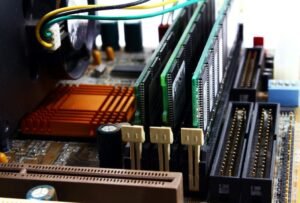Why Neuralink Will Change Humanity Forever
Neuralink, a neurotechnology company founded by Elon Musk, is set to revolutionize the way we interact with technology and understand the human brain.
Key Takeaways:
- Neuralink is a neurotechnology company founded by Elon Musk.
- Neuralink aims to enhance human capabilities by merging the human brain with artificial intelligence.
- The technology behind Neuralink involves implanting tiny electrodes into the brain to establish a high-bandwidth brain-machine interface.
- This technology has the potential to treat neurological disorders and enhance cognitive abilities.
Neuralink’s breakthrough lies in its ability to establish a direct connection between the brain and computer systems. By implanting tiny electrodes into the brain, Neuralink can create a high-bandwidth brain-machine interface. This interface allows for bidirectional communication between the brain and external devices, enabling humans to control technology with their thoughts and receive sensory feedback directly from the devices.
Furthermore, Neuralink’s technology has the potential to treat various neurological disorders. By targeting specific areas of the brain and stimulating or inhibiting neural activity, Neuralink could alleviate symptoms of conditions such as Parkinson’s disease, epilepsy, or spinal cord injuries. The ability to restore lost motor function or reduce seizures through targeted brain stimulation opens up new possibilities for patients and improves their quality of life.
The Advantages of Neuralink’s Brain-Machine Interface
- Increased communication speed: Neuralink’s interface can transmit and receive information at a much faster rate than our current methods of communication.
- Enhanced cognitive abilities: The merging of AI with the human brain could enhance memory, learning, and decision-making capabilities.
- Treatment of neurological disorders: Neuralink’s technology has the potential to treat various neurological conditions and restore lost function.
One of the most intriguing aspects of Neuralink is its potential to enhance human cognition. By seamlessly integrating artificial intelligence with our brains, we could potentially access information and process it at an unprecedented rate. This could lead to an expansion of human capabilities and open up new frontiers in fields such as education, medicine, and scientific research.
| Neuralink | BCI Method A | BCI Method B |
|---|---|---|
| Implants electrodes directly into the brain | Uses surface electrodes on the scalp | Uses implants in peripheral nerves |
| Higher bandwidth and more precise control | Lower bandwidth and limited control | Moderate bandwidth and control |
| Potential for treating neurological conditions | Limited potential for treatment | Potential for treating certain conditions |
In addition to the medical benefits, Neuralink’s technology also raises ethical and privacy concerns. The integration of our minds with technology prompts questions about data security, personal privacy, and the potential for misuse. It is crucial to establish ethical guidelines and robust safeguards to prevent abuse and protect individuals’ rights.
Neuralink’s Potential Impact on Society
- Advancements in education and learning
- Improved treatment options for neurological conditions
- Increased human-machine collaboration in various industries
Neuralink’s groundbreaking technology has the potential to change society as we know it. While there are still many challenges to overcome, the possibilities offered by merging the human brain with AI are immense. From revolutionizing education and healthcare to enabling new forms of human-machine collaboration, Neuralink’s impact on humanity will be profound and far-reaching.
| Treatment Method | Limitations | Neuralink’s Advantages |
|---|---|---|
| Medication | Side effects, dependence, limited efficacy | Potentially targeted and precise treatment |
| Physical therapy | Time-consuming, limited availability, gradual progress | Potential for rapid recovery and improved outcomes |
| Surgical interventions | Invasiveness, risk of complications | Minimally invasive procedures with improved safety |
In conclusion, Neuralink’s innovative technology has the potential to revolutionize humanity by enhancing human capabilities and treating neurological disorders. While the integration of technology with our brains poses ethical and privacy challenges, the overall impact on society could be tremendous. With further advancements and careful consideration of the associated risks, Neuralink has the potential to reshape how we interact with technology and unlock new possibilities for human potential.

Common Misconceptions
Misconception 1: Neuralink technology will control people’s thoughts and actions
One common misconception about Neuralink technology is that it will have the power to control people’s thoughts and actions. This misconception likely stems from the notion that Neuralink is implanting chips directly into the brain. However, it is important to understand that Neuralink’s goal is to enhance human capabilities and not to exert control over individuals.
- Neuralink technology aims to augment human intelligence, memory, and cognitive abilities.
- The technology primarily focuses on treating neurological disorders such as paralysis, Alzheimer’s, and Parkinson’s.
- Neuralink’s purpose is to establish a symbiotic relationship between humans and AI, allowing for collaboration and expanded possibilities.
Misconception 2: Neuralink will replace human jobs with AI
Another widespread misconception is that Neuralink’s advances will lead to widespread job losses as AI takes over various industries. While it is true that AI has the potential to automate certain tasks, Neuralink’s objective is to work in harmony with humans, rather than replacing them entirely.
- Neuralink technology can enhance human productivity and performance in various fields.
- The integration of Neuralink with AI is designed to facilitate human-AI collaboration, improving efficiency and innovation.
- The technology can also create new job opportunities in areas such as brain-computer interface development and neuroscience research.
Misconception 3: Neuralink is an invasive and unsafe procedure
Contrary to popular belief, Neuralink’s procedure is not invasive or unsafe. The misconceptions surrounding the procedure might arise from the perception that brain surgery is inherently risky. However, Neuralink’s technology has been developed with utmost care and precision to ensure the safety and well-being of its users.
- Neuralink’s surgical procedure is minimally invasive, involving a small incision and the use of robotic devices.
- Safety measures, such as sterilization and careful monitoring, are implemented throughout the procedure.
- The technology undergoes rigorous testing and regulatory scrutiny to ensure its efficacy and safety.
Misconception 4: Neuralink is only for the wealthy and elite
There is a common misconception that Neuralink’s technology will only be accessible to the wealthy and elite, limiting its potential impact on humanity. While the technology is currently being developed and tested, Neuralink’s aim is to eventually make its innovations affordable and accessible to as many people as possible.
- Neuralink is committed to developing a scalable and affordable method for implanting the brain-computer interface.
- The company’s long-term vision includes making Neuralink technology available to treat a wide range of neurological disorders, benefiting people from diverse socioeconomic backgrounds.
- Neuralink’s success in innovating and producing cost-effective solutions can potentially drive down the overall cost of healthcare and make it more accessible for all.
Misconception 5: Neuralink will fundamentally change human nature
Some misconceptions suggest that Neuralink’s advancements will fundamentally change human nature, altering our identity or making us less human. However, Neuralink’s technology is intended to enhance human capabilities and enrich our lives rather than altering the core aspects that define our humanity.
- Neuralink aims to enable individuals to achieve their full potential by expanding cognitive abilities, memory, and creativity.
- The technology can help restore lost functionalities due to neurological disorders, empowering individuals to live fuller and more independent lives.
- Neuralink embraces the idea that humans and AI can synergistically coexist, creating new avenues for collaboration and discovery.

Table: Average Life Expectancy
In recent years, average life expectancy has steadily increased due to advancements in medical technology and healthcare. This table highlights the average life expectancy in select countries.
| Country | Male Life Expectancy | Female Life Expectancy | Overall Life Expectancy |
|---|---|---|---|
| Japan | 81.1 | 87.3 | 84.2 |
| Australia | 79.9 | 84.8 | 82.4 |
| United States | 76.4 | 81.2 | 78.8 |
Table: Internet Penetration Rates
The global internet usage has been rapidly increasing, bringing people closer and facilitating access to vast amounts of information. This table shows the internet penetration rates in different regions of the world.
| Region | Internet Penetration Rate (%) |
|---|---|
| North America | 99.5 |
| Europe | 85.2 |
| Asia | 59.5 |
Table: Global Smartphone Sales
The rise of smartphones has revolutionized the way we communicate, access information, and perform various tasks. This table showcases global smartphone sales by selected manufacturers in a particular year.
| Manufacturer | Number of Units Sold (in millions) |
|---|---|
| Samsung | 296.2 |
| Apple | 215.8 |
| Huawei | 154.3 |
Table: Global Research and Development Expenditure
Dedication to research and development plays a vital role in the advancement of technology. This table presents the top countries investing in research and development as a percentage of their Gross Domestic Product (GDP).
| Country | R&D Expenditure (% of GDP) |
|---|---|
| South Korea | 4.55 |
| Israel | 4.43 |
| Sweden | 3.39 |
Table: Global Carbon Dioxide Emissions
Climate change is a significant concern, and monitoring global carbon dioxide emissions is crucial to understanding its impact. This table displays the top emitters of carbon dioxide in million metric tons (2019 data).
| Country | Carbon Dioxide Emissions (million metric tons) |
|---|---|
| China | 10,065.0 |
| United States | 5,416.0 |
| India | 2,654.0 |
Table: Global Renewable Energy Consumption
To combat climate change, the world is increasing its focus on renewable energy sources. This table presents the top countries in terms of renewable energy consumption in million tonnes of oil equivalent (2018 data).
| Country | Renewable Energy Consumption (million tonnes of oil equivalent) |
|---|---|
| China | 1,885.6 |
| United States | 1,024.8 |
| Brazil | 479.1 |
Table: Global Internet Users and Social Media Users
The digital age has witnessed a surge in internet and social media usage. This table presents the number of internet users and social media users worldwide (2021 data).
| Internet Users (billions) | Social Media Users (billions) | |
|---|---|---|
| Global | 4.9 | 4.2 |
| Asia-Pacific | 2.7 | 2.6 |
Table: Global Cybersecurity Spending
As digital threats continue to grow, investing in cybersecurity becomes increasingly essential. This table displays the countries with the highest cybersecurity spending in billion U.S. dollars (2019 data).
| Country | Cybersecurity Spending (billion USD) |
|---|---|
| United States | 53.3 |
| China | 24.3 |
| United Kingdom | 8.5 |
Table: Global Artificial Intelligence Market Revenue
The artificial intelligence market has been growing rapidly, transforming various industries. This table showcases the global revenue generated from artificial intelligence in billion U.S. dollars (2021 data).
| Industry | Revenue (billion USD) |
|---|---|
| Healthcare | 22.8 |
| Retail | 10.2 |
| Automotive | 5.1 |
The world is constantly evolving, and technological advancements have played a significant role in shaping our future. One such technological breakthrough is Neuralink, a revolutionary brain-machine interface technology developed by Elon Musk. Neuralink aims to bridge the gap between humans and artificial intelligence by implanting tiny electrodes into the human brain, allowing direct communication and interaction with computers, transforming various aspects of our lives.
The tables presented above depict different aspects of the technological landscape that Neuralink will shape. From the increase in average life expectancy to the proliferation of the internet, smartphones, and renewable energy consumption, these tables illustrate how society has embraced innovation and transformed different sectors. Moreover, they highlight the continuous need for advancements in cybersecurity and global spending on research and development, reflecting the world’s investments in securing and enhancing future technologies.
Neuralink’s potential impact on humanity is immense. With the ability to directly interface with the human brain, this technology holds promises of medical breakthroughs, enhanced cognition, and the potential for a symbiotic relationship between humans and artificial intelligence. As we continue to push the boundaries of technological advancements, Neuralink represents a significant leap forward, paving the way for a future where humans and machines coexist in ways we previously only imagined.
Frequently Asked Questions
How does Neuralink work?
Neuralink is a brain-machine interface technology that uses ultra-thin, flexible electrodes to implant in the brain, allowing for a high-bandwidth connection between the brain and external devices. These electrodes can stimulate and record brain activity, enabling the exchange of information between the brain and computers or other devices.
What are the potential benefits of Neuralink?
Neuralink has the potential to revolutionize various aspects of human life. It could help individuals with neurological disorders regain lost functionality, enhance cognitive abilities, and enable seamless brain-computer interactions. Moreover, Neuralink may eventually pave the way for the integration of artificial intelligence with the human brain, leading to significant advancements in areas like machine learning and data analysis.
Are there any risks or side effects associated with Neuralink?
As with any invasive medical procedure, there are risks involved with Neuralink. Some potential risks include infection, bleeding, or damage to the brain tissue during the implantation process. Additionally, there could be unforeseen long-term effects on brain function or unintended consequences stemming from the use of brain-machine interfaces. Extensive research and rigorous testing are necessary to mitigate these risks.
Can Neuralink be used to enhance human intelligence?
Theoretically, Neuralink has the potential to enhance human intelligence by allowing direct access to advanced computational systems. By integrating the human brain with artificial intelligence, it could enable individuals to quickly access vast amounts of information, enhance learning capabilities, and potentially improve problem-solving skills. However, it is important to note that the ethical implications and potential impact on societal structures must be carefully considered.
Will Neuralink replace the need for traditional educational methods?
Neuralink alone cannot replace traditional educational methods. While it may facilitate information transfer and enhance cognitive abilities, education is a complex process that involves various social, emotional, and interpersonal aspects. Neuralink could be a valuable tool in education, but it is unlikely to completely replace traditional methods of teaching and learning.
What are the implications of Neuralink for privacy and data security?
Neuralink raises significant concerns regarding privacy and data security. As the technology involves connecting the brain to external devices, there is a potential for unauthorized access to neural data or manipulation of brain signals. Strict regulations and robust security measures would be necessary to protect user privacy, prevent misuse of data, and ensure the ethical use of this technology.
Can Neuralink be used for mind control or mind reading?
No, Neuralink is not designed for mind control or mind reading. Its purpose is to establish a bidirectional communication channel between the brain and external devices. While it may enable the control of certain external devices through brain signals, it does not grant the ability to control thoughts or read minds.
Is Neuralink accessible to everyone?
Currently, Neuralink is in its early stages of development and is not accessible to the general public. However, Elon Musk, the founder of Neuralink, aims to make the technology more accessible and affordable in the future. As the technology progresses and becomes safer and more reliable, it may eventually be available to a wider range of individuals.
What are the ethical considerations surrounding Neuralink?
Neuralink raises several ethical considerations that need to be addressed. These include issues related to privacy, consent, data ownership, potential social inequality, and the overall impact on human autonomy and identity. Responsible development, regulation, and ongoing ethical discussions are crucial to ensuring the proper and beneficial use of this technology.
How long will it take for Neuralink to have a significant impact?
The timeline for Neuralink to have a significant impact is uncertain. The technology is still in its early stages and requires further research and development. The pace of progress will depend on various factors, including successful clinical trials, regulatory approvals, public acceptance, and advancements in related fields. However, given the potential transformative nature of Neuralink, it is expected to have a long-lasting impact on humanity.




